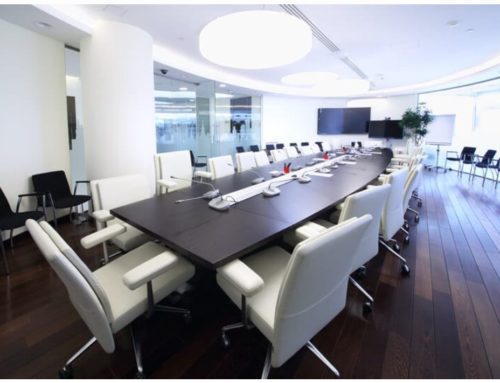The concept of remote work is not new in this globalized world. An increasing number of people are working across borders and time zones. As companies confront the realities of a new normal, many have transitioned to a hybrid work model that demands increased flexibility from both people and technology in the workplace.
Hybrid work combines remote work and time in the office. It gives employees the flexibility to switch between working from home for individual tasks and the office for face-to-face meetings. This new arrangement also affects the way companies create, collaborate, and communicate.
There is a need to embrace innovative approaches and smart AV technology to navigate this emerging working environment. The last thing businesses want is productivity and efficiency to fall due to a lack of proper digital infrastructure.
Just setting up for a meeting and getting presenters connected can waste valuable time. As meetings are already a huge time commitment, it’s essential to minimize wasted time (and the frustration it causes). Existing solutions include projectors, interactive whiteboards, and complex wireless presentation systems, but some situations call for a simpler – but still elegant – device in the form of a wireless presentation display.
Wireless presentation displays are an ideal way to conduct physical and virtual meetings in a changing environment. The budget- and user-friendly device transforms conference rooms into reservoirs of ideas, where on-site and remote workers can brainstorm and participate effortlessly.
What is a Wireless Presentation Display?
Also referred to as WPDs, Wireless Presentation Displays are high-quality flat-panel displays with built-in videoconferencing capabilities, wireless connectivity, screen sharing, and other multimedia display functions. They provide a gateway for companies to better adapt to a hybrid workforce in a virtual space with a single integrated device.
Their purpose is to make content sharing easier with no cables and no interruptions from switching sources. A WPD should also include the ability to share multiple screens at once – even from multiple locations – allowing for easier collaboration during meetings and presentations. They should also support videoconferencing peripherals in the form of cameras and microphones.
As a simplified integrated system, wireless presentation displays allow multiple users to connect seamlessly, share content from their devices, and not have to fiddle with the shared cables so common to modern meeting rooms.
How Wireless Presentation Display is Different from a Wireless Presentation System?

A wireless presentation system (WPS) is a hardware solution for integrating multiple other devices into a wireless system. Usually, it is a box that physically connects some combination of stand-alone displays, wireless routers, cameras, microphones, and other necessary peripherals.
Standard displays without built-in wireless connectivity also require external dongles to attach new devices, a problem that WPDs address by allowing known users to connect automatically through an application.
Wireless presentation displays shine in situations where one or many devices are going to connect to the same shared display. The device makes it easy to connect wirelessly from anywhere in the room and switch displays without interrupting the presentation, so it’s great for teams that frequently meet and collaborate.
Given their wireless connectivity, WPDs also make it easier for IT to manage the devices. Especially handy in large organizations, an IT manager can change configurations and directly share content over the network instead of having to manually address every problem.
Wireless presentation displays also fill a specific need between projectors and interactive whiteboards, though all three are displays well suited to certain situations. While they typically have a lower initial cost, projectors have a higher total cost of ownership (TCO) than flat-panel displays due to regular maintenance and a larger number of moving parts that could break (e.g. fans). Also, unless you are using a fixed projector with wireless integration, there’s a good chance you will have to spend time calibrating the device each time you use it.
On the other hand, interactive whiteboards (IWBs) are a more advanced – and more expensive – option that takes advantage of a flat-panel display and add touchscreen functionality for digital whiteboarding. However, the additional functions may not be necessary or even interfere with the regular use of the display. Using a touch screen also requires close proximity, which can block many viewing angles for large teams’ collaborations.
Common Uses for a Wireless Presentation Display

As one of several devices available, it’s important to know where a WPD is actually the best choice. The easy connectivity, screen sharing, and image quality combined with a reasonably priced, integrated system certainly benefit a number of environments as mentioned below:
Meeting Rooms, Conference Rooms and Huddle Spaces
They are the most likely candidates for a wirelessly connected display. It’s an ideal solution for presentations and collaboration from individual devices, especially when multiple screens are shared at once. And since most meetings happen while everyone is in their seats, a large touchscreen display isn’t strictly necessary.
Training Rooms
Training rooms can also use the combined connectivity and screen sharing of wireless presentation displays, especially with 2-way screencasting. Even if the trainee can’t see the main display, the trainer can share their screen with everyone with the click of a button. A larger training venue – or even a school – could even cast to multiple large WPDs simultaneously.
Small-and-Medium Sized Classrooms
They are also good places for a front-of-classroom display like this. They work especially well where the lesson format is mostly lectures, especially in higher education, or as one of several classroom projector alternatives.
Commercial Display
Commercial display in retail outlets and public spaces was one of the original functions of large-format displays like WPDs. Going wireless has the additional benefit of reducing the need for data cables and other problematic infrastructure. Keep displays up to date with nothing more than a power source.
Office Communications
This is a more novel use for digital displays, but one that has a lot of merits. Having high-quality, dynamic displays around the office is a great way to improve internal communication and employee engagement.
How Businesses can Benefit from Wireless Presentation Displays
Meetings are a mainstay in corporate culture. They help align project progress, enable new ideas, and build team cohesion. However, they come with a myriad of challenges. From a lack of structure to poor time management, bad meetings can drain precious time and energy.
Executing a better meeting can be achieved with the aid of wireless presentation displays. The device rethinks how to have meetings, whether in a single location or dispersed across the globe.
Effective Communication
Clear communication is essential for the success of any company. A breakdown can impede productivity, create a stressful work environment and even, cause projects to fall through. With the shift towards a hybrid workforce, virtual communication breakdowns can be a potential problem.
WPDs bring all participants, whether in the office or remotely, together in one virtual location seamlessly. It provides brilliant image quality and high-fidelity sound for effective collaborations. Discussions can be heard crystal clear, and fewer visual cues lost through pixels.
These user-friendly displays have the ability to split into multiple screens. This provides ample virtual space to feature graphs and data for comparison, allowing teams to become more productive and make better decisions.
Encourage Participation
Bad meetings often relegate some participants to the backseat. It reduces the employees’ sense of commitment and discourages them from sharing ideas. WPDs are a great way to engage and empower all participants to be part of the collaboration.
They allow participants to connect wirelessly and seamlessly from any location, without interrupting the presentation or using multiple cables. Equipped with added video conferencing features, each worker can be seen and heard clearly. They can even cast content from their devices onto the display, transforming the simple meeting into a communications hub.
WPDs for Optimal Workflows
The uptake of hybrid work structures means paperwork must be digitized and massive content to be shared. It will require a robust Wi-Fi connection, secure cloud storage, and a user-friendly interface. WPDs smooth content-heavy workflows and improves productivity in a mixed office environment.
Maximize Efficiency
Time often translates to money in an economy. Wasted time due to inefficient business operations can lead to high costs and unproductive employees. Wireless presentation displays can help streamline time-consuming setups and reduce redundant applications.
Employees can easily access and share documents and multimedia from a secure cloud management system. Multiple users can also simultaneously stream, edit and transfer their content on the display in real-time. There is less time wasted on tracking down files and more for high-level assignments.
WPDs for Offices of the Future
As workforces continue to evolve, companies need to reimagine conference spaces and adopt smart digital conferencing solutions. Offices of the future will have to support mixed working arrangements and physical distancing without compromising communication and productivity. Wireless presentation displays are an indispensable tool to adjust employees to a virtual setting and ensure that offices are future-ready.
Would You be Interested in Trying on WPD’s for Your Business?

In an ever-changing landscape, businesses face constant risks and uncertainties. Wireless presentation displays are a cost-effective way to better equip your company and workforce for a rapidly evolving future.
The wireless presentation display (WPD) is a new class of collaborative display. It simplifies the setup and operation of a shared screen by integrating all the necessary hardware and software to provide a streamlined collaborative device. By occupying a space between a clunky, jury-rigged conference room TV and a more advanced interactive whiteboard, WPDs offer a solution to organizations looking to move away from projectors without breaking the bank on unnecessary features.
Choosing the best presentation display for your business is a valuable investment in the long run. Get in touch with us for scheduling a demo on WPD’s to get convinced on the benefits for your business.
Author



